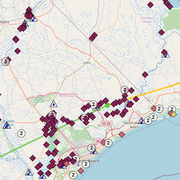Essential Tools and Products
Essential Tools and Products
National Water Dashboard
Our new interactive, mobile-friendly tool provides real-time water, weather, and flood information all in one place
Our new interactive, mobile-friendly tool provides real-time water, weather, and flood information all in one place
National Hydrography Dataset (NHDPlus)
Data Analysis Tools in the R Programming Language
The USGS Water Science School
Our most popular water-resource data, tools, software, and services.
Filter Total Items: 21
StreamStats: Streamflow Statistics and Spatial Analysis Tools for Water-Resources Applications
StreamStats provides access to spatial analytical tools that are useful for water-resources planning and management, and for engineering and design purposes. The map-based user interface can be used to delineate drainage areas, get basin characteristics and estimates of flow statistics, and more. Available information varies from state to state.
SPARROW modeling: Estimating nutrient, sediment, and dissolved solids transport
SPARROW (SPAtially Referenced Regression On Watershed attributes) models estimate the amount of a contaminant transported from inland watersheds to larger water bodies by linking monitoring data with information on watershed characteristics and contaminant sources. Interactive, online SPARROW mapping tools allow for easy access to explore relations between human activities, natural processes, and...
Hydroacoustics
Since the early 1980s the USGS has worked cooperatively with manufacturers to develop and enhance the use of acoustic Doppler instruments for streamflow and other hydraulic measurements. This site provides information on hydroacoustic technology, instruments, and their use.
Data Science for Water Resources
Data scientists in the USGS Water Resources Mission Area make sense of large environmental and operational datasets by applying various modeling, statistical, and visualization techniques to generate actionable information.
Providing Major Storm and Short-Term Flood Event Data
During major storms or other short-term events, the USGS collects streamflow and additional data to help document high-water events. This data is uploaded to the Short-Term Network (STN) for long-term archival and served out to the public through the Flood Event Viewer (FEV) which provides convenient, map-based access to downloadable event-based data.
Quality Systems Branch (QSB)
The USGS Quality Systems Branch (QSB) represents the Water Resource Mission Area’s commitment to generating environmental data of known quality. QSB produces water and sediment performance-assessment samples and data to provide the USGS laboratory users, USGS laboratories, and field personnel with quantitative performance information to assess data quality.
USGS Cooperative Matching Funds
USGS Cooperative Matching Funds (CMF) support joint projects with our state, regional, tribal, and local partners to provide reliable, impartial, and timely information needed to understand and manage the Nation's water resources.
National Field Manual for the Collection of Water-Quality Data (NFM)
The National Field Manual for the Collection of Water-Quality Data (NFM) provides documented methods and protocols for USGS field personnel who collect water-quality data. The NFM provides detailed, comprehensive, and citable procedures for sampling water resources, processing samples for analysis of water quality, measuring field parameters, and specialized procedures.
Flood Inundation Mapping Science
When planning for a flood, there are three key questions that must be answered: What areas will be flooded? How deep will the flood waters get? When will the flood arrive? Historical flooding can help a community anticipate how much impact similar flood events could have, but there are other methods and tools that can provide more accurate and nuanced estimations of a wide variety of flood...












